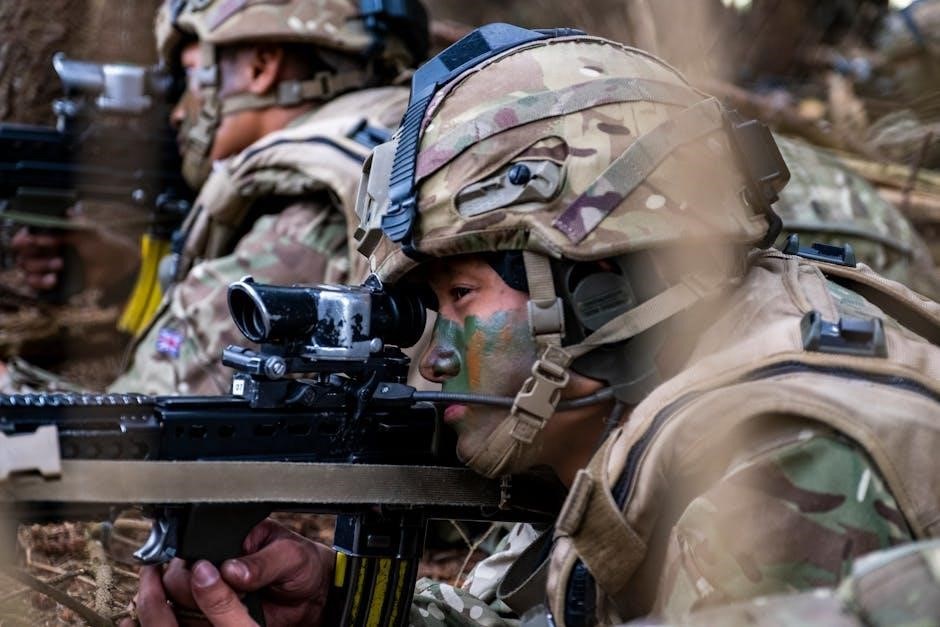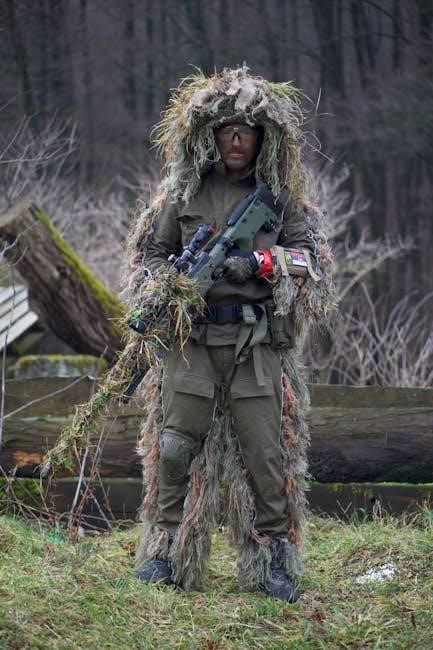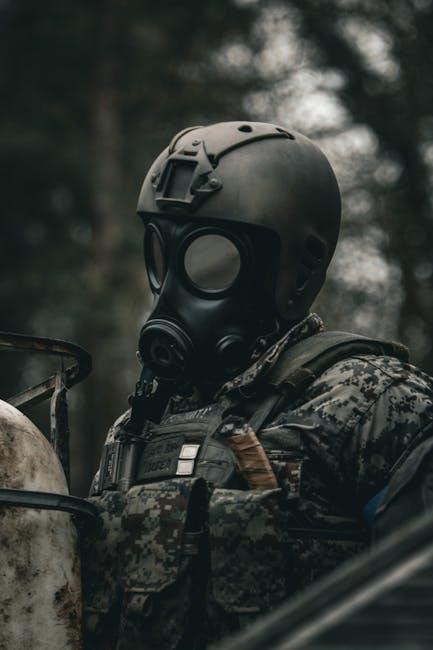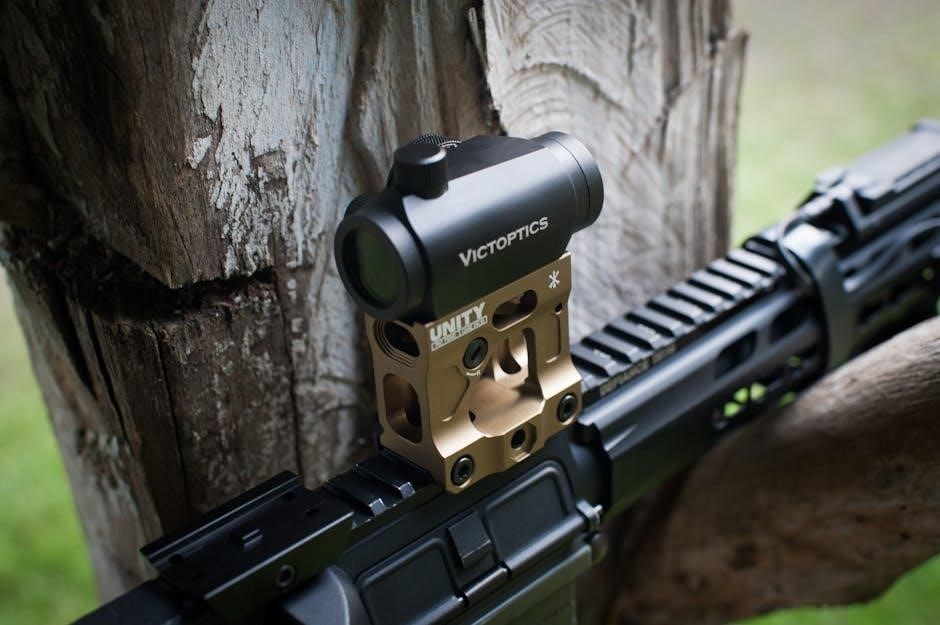army survival guide
Army survival skills are critical for military personnel to navigate challenging environments‚ ensuring they can respond to emergencies and sustain themselves in hostile conditions with confidence․
1․1 Importance of Survival Training in the Military
Survival training is crucial for military effectiveness‚ ensuring personnel can overcome life-threatening challenges․ It equips soldiers with skills to survive in hostile environments‚ evade capture‚ and sustain themselves until recovery․ This training fosters mental resilience‚ resourcefulness‚ and confidence‚ enabling soldiers to operate effectively under stress․ By mastering survival techniques‚ military members enhance their ability to complete missions and return safely‚ even in the most extreme conditions․ These skills are vital for both individual survival and unit success in diverse operational scenarios․
1․2 Overview of Key Survival Skills Taught in the U․S․ Military
The U․S․ military teaches a wide range of survival skills to ensure personnel can thrive in hostile environments․ Key skills include finding food and water‚ building shelters‚ starting fires without modern tools‚ and navigating using maps‚ compasses‚ and natural landmarks․ Soldiers also learn survival techniques for diverse climates‚ such as jungles‚ deserts‚ and arctic regions․ Additionally‚ training covers evasion methods to avoid capture‚ resistance strategies‚ and escape tactics․ These skills are complemented by psychological preparedness and physical conditioning to enhance endurance and resilience in survival situations․

The U․S․ Army Survival Manual (FM 21-76)
The U․S․ Army Survival Manual (FM 21-76) is a comprehensive guide detailing survival techniques for various environments‚ ensuring soldiers can sustain life in hostile conditions effectively․
2․1 Key Chapters and Topics Covered in the Manual
The U․S․ Army Survival Manual (FM 21-76) covers essential survival topics‚ including survival psychology‚ water procurement‚ food sourcing‚ shelter construction‚ and fire starting․ It details navigation techniques using maps‚ compasses‚ and natural landmarks‚ as well as signaling methods for rescue․ The manual also addresses survival in diverse environments‚ such as jungles‚ deserts‚ and arctic regions‚ and includes sections on first aid‚ equipment maintenance‚ and survival tools․ Additionally‚ it emphasizes the importance of adapting to different terrains and climates to stay alive․ This comprehensive guide is a vital resource for military personnel facing survival challenges․
2․2 Practical Applications of the Manual in Real-World Scenarios
The U․S․ Army Survival Manual is widely applied in real-world scenarios‚ equipping soldiers with actionable strategies for survival․ It has been used in jungle warfare training‚ arctic missions‚ and desert operations‚ helping soldiers navigate unfamiliar terrains and utilize local resources․ For example‚ the manual’s techniques for finding food and water have been crucial in sustainment during extended deployments․ Its navigation methods have aided soldiers in evading capture and returning to base․ Real-world applications highlight the manual’s effectiveness in preparing military personnel for diverse and hostile environments‚ ensuring their safety and operational success in critical situations․
Core Survival Skills for Military Personnel
Core survival skills for military personnel include finding food‚ building shelter‚ starting fires‚ and navigation․ These skills are essential for enduring hostile environments and emergency situations‚ ensuring preparedness and resilience․
3․1 Finding Food and Water in the Wilderness
Finding food and water in the wilderness is a critical survival skill․ Military personnel are trained to identify edible plants‚ use water purification techniques‚ and collect rainwater․ They learn to locate water sources like streams or ponds and avoid contaminated supplies․ Solar disinfection and filtration methods are emphasized to ensure safe drinking water․ Food procurement includes hunting‚ trapping‚ and foraging‚ with a focus on energy-efficient methods․ Rationing food and water is also taught to sustain resources during extended periods․ These techniques ensure survival in hostile environments by leveraging natural resources effectively․
3․2 Building Shelter and Protecting Yourself from the Elements
Building shelter and protecting oneself from the elements is essential for survival․ Military training emphasizes using natural materials like leaves‚ branches‚ and snow to construct lean-tos‚ debris huts‚ or snow shelters․ Understanding weather patterns helps in creating shelters that withstand wind‚ rain‚ or extreme cold․ Soldiers also learn to dig foxholes for cover and use ponchos or tarps for waterproofing․ Insulation and camouflage are critical to avoid detection and retain body heat․ These techniques ensure protection from harsh environmental conditions‚ enhancing safety and endurance in the wilderness․
3․3 Starting a Fire Without Modern Tools
Starting a fire without modern tools is a vital survival skill․ Military training teaches techniques like flint-and-steel‚ bow drill‚ and hand drill methods․ These methods require patience and practice to generate an ember․ Once lit‚ fires provide warmth‚ a way to cook food‚ and a signal for rescue․ Soldiers learn to use dry‚ fluffy material for kindling and larger logs to sustain the fire․ Proper fire management is also emphasized to avoid detection and conserve resources․ Fire starting is a cornerstone of wilderness survival‚ ensuring basic needs are met in challenging environments․

Navigation and Orientation Techniques
Navigation and orientation are crucial for military survival․ Techniques include using maps‚ compasses‚ natural landmarks‚ celestial navigation‚ and terrain association to determine position and direction accurately․ Essential skills for survival․
4․1 Using Maps‚ Compasses‚ and Natural Landmarks
Mastering the use of maps‚ compasses‚ and natural landmarks is essential for navigation․ Maps provide detailed terrain information‚ while compasses offer precise directional guidance․ Natural landmarks‚ such as rivers‚ mountains‚ and vegetation patterns‚ help soldiers orient themselves in unfamiliar environments․ By combining these tools‚ military personnel can accurately determine their position and plan effective routes․ Celestial navigation‚ using the sun and stars‚ further enhances these skills․ Understanding contour lines‚ scale‚ and symbols on maps ensures accurate interpretation․ These techniques are vital for survival‚ especially when modern GPS devices are unavailable or unreliable․
4․2 Survival Navigation in Unfamiliar Terrain
Navigating unfamiliar terrain requires a combination of observation‚ adaptability‚ and skill․ Soldiers use techniques like terrain association‚ where they match visible features to their maps․ Pace counting helps estimate distances traveled‚ ensuring accurate positioning․ Natural indicators‚ such as the direction of tree growth or animal tracks‚ can also guide navigation․ In environments without distinct landmarks‚ soldiers rely on creating mental maps and using dead reckoning․ These methods enhance situational awareness and reduce the risk of disorientation․ Effective navigation in such conditions is crucial for mission success and personal safety‚ especially in hostile or remote areas․
Survival‚ Evasion‚ Resistance‚ and Escape (SERE) Training
SERE Training prepares military personnel to survive‚ evade‚ resist‚ and escape captivity‚ ensuring they can withstand and overcome hostile environments with resilience and skill effectively;
5․1 Understanding the SERE Framework
The SERE (Survival‚ Evasion‚ Resistance‚ and Escape) framework is a comprehensive training program designed to equip military personnel with the skills to survive captivity and hostile environments․ Developed during World War II‚ SERE training emphasizes resilience‚ resourcefulness‚ and adherence to military codes of conduct․ The framework is divided into four phases: survival‚ evasion‚ resistance‚ and escape․ Each phase teaches specific strategies‚ from finding food and water to evading capture and resisting interrogation․ SERE training also focuses on psychological preparedness‚ ensuring individuals can withstand physical and mental challenges․ This structured approach ensures military personnel can return with honor‚ maintaining their integrity and mission focus․
5․2 Evasion Techniques to Avoid Capture
Evasion techniques are critical for military personnel to avoid capture in hostile environments․ These methods include using natural cover‚ moving during low-visibility conditions‚ and creating false trails to confuse pursuers․ Soldiers are trained to alter their movement patterns‚ avoid detectable signs‚ and remain silent to evade detection․ Mental preparedness and situational awareness are emphasized to stay one step ahead of adversaries․ Evasion skills are refined through rigorous SERE training‚ ensuring personnel can effectively avoid capture while maintaining their mission focus and survival mindset․
5․3 Resistance and Escape Strategies
Resistance and escape strategies are integral to SERE training‚ focusing on maintaining mental resilience and devising plans to break free from captivity․ Techniques include creating diversions‚ using improvised tools‚ and exploiting weaknesses in confinement․ Psychological preparedness is key to enduring interrogation and maintaining resolve․ Escape strategies emphasize patience‚ timing‚ and leveraging opportunities to regain freedom․ These methods are honed through realistic simulations‚ ensuring personnel can resist exploitation and escape with honor‚ aligning with the core principle of survival training: to survive‚ resist‚ and return with dignity․

Environmental Survival Techniques
Environmental survival techniques equip personnel to thrive in diverse climates and terrains‚ emphasizing adaptability‚ resource management‚ and resilience to overcome natural challenges effectively․
6․1 Surviving in Jungle‚ Desert‚ and Arctic Environments
Surviving in extreme environments requires tailored strategies․ In jungles‚ soldiers navigate dense vegetation‚ manage humidity‚ and locate water sources․ Desert survival focuses on managing extreme heat‚ conserving water‚ and avoiding dehydration․ Arctic environments demand techniques to withstand freezing temperatures‚ build snow shelters‚ and prevent hypothermia․ Each climate presents unique challenges‚ but core principles like resourcefulness‚ shelter-building‚ and water procurement remain critical․ Training emphasizes adapting to terrain-specific risks‚ such as wildlife in jungles or blizzards in arctic regions․ Mastery of these skills ensures resilience in the most hostile natural settings‚ enabling soldiers to operate effectively worldwide․
6․2 Adapting to Different Terrains and Climates
Adapting to diverse terrains and climates is a cornerstone of military survival training․ Soldiers learn to analyze terrain features‚ such as elevation‚ vegetation‚ and water sources‚ to navigate effectively․ Climate-specific strategies include using layered clothing for temperature regulation and understanding weather patterns to predict storms․ Whether in mountains‚ swamps‚ or urban settings‚ the ability to adjust tactics ensures survival․ Training emphasizes versatility‚ enabling personnel to thrive in unpredictable environments by leveraging natural resources and applying climate-appropriate techniques․ This adaptability is crucial for mission success and personal safety in any operational theater․

Psychological and Physical Preparedness
Psychological resilience and physical endurance are vital for survival․ Mental toughness enables soldiers to stay focused under stress‚ while physical conditioning ensures stamina for prolonged challenges in the field․
7․1 Mental Toughness and Resilience in Survival Situations
Mental toughness and resilience are cornerstone traits for soldiers facing survival challenges․ These qualities enable individuals to manage fear‚ stay focused‚ and make rational decisions under extreme stress․ Techniques such as positive thinking‚ emotional regulation‚ and a “survival mindset” are cultivated through rigorous training․ Soldiers learn to embrace challenges as opportunities to adapt and overcome‚ fostering a mindset that prioritizes resourcefulness and determination․ This psychological preparedness‚ combined with physical skills‚ ensures they remain calm and effective in life-threatening scenarios‚ ultimately enhancing their ability to survive and thrive in hostile environments․
7․2 Physical Conditioning for Endurance and Survival
Physical conditioning is essential for soldiers to endure the demands of survival situations․ Strength‚ endurance‚ and cardiovascular health are prioritized to sustain prolonged physical exertion in extreme environments․ Training includes exercises that enhance stamina‚ agility‚ and the ability to carry heavy loads over long distances․ Soldiers are prepared to survive for extended periods without resupply‚ emphasizing the importance of a robust physical state․ This conditioning ensures they can perform tasks like navigating challenging terrains and executing survival skills effectively‚ even in the most physically demanding scenarios encountered during missions or emergencies․
Mastering army survival skills ensures resilience in hostile environments‚ equipping personnel to survive and thrive through proven techniques and continuous training‚ essential for staying alive and fulfilling missions effectively․
8․1 Summarizing the Essential Survival Skills
The U․S․ military emphasizes key survival skills‚ including finding food and water‚ building shelters‚ navigation‚ and starting fires․ These techniques ensure sustainability in hostile environments․ Psychological resilience and physical endurance are also critical‚ enabling soldiers to remain focused and adaptable․ SERE training further equips personnel with evasion and resistance strategies‚ while environmental adaptation skills address diverse terrains like jungles‚ deserts‚ and arctic regions․ Continuous practice and refinement of these skills are vital for mission success and survival‚ ensuring soldiers can overcome any challenge with confidence and precision․
8․2 The Role of Continuous Training in Survival Mastery
Continuous training is vital for mastering survival skills‚ ensuring soldiers remain adaptable and proficient․ Regular practice sharpens abilities like navigation‚ foraging‚ and shelter-building‚ keeping them relevant in dynamic environments․ Training fosters situational awareness and mental resilience‚ crucial for overcoming unexpected challenges․ By refining techniques and learning new strategies‚ soldiers enhance their survival instincts․ This ongoing process ensures skills evolve with changing scenarios‚ equipping personnel to thrive in any situation․ Ultimately‚ continuous training is the cornerstone of survival mastery‚ transforming knowledge into instinctive actions that save lives and ensure mission success․
